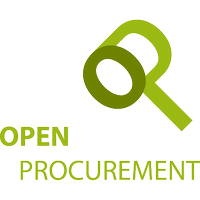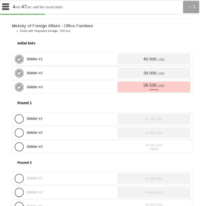OpenProcurement
OpenProcurement is an open source procurement software toolkit that automates procurement processes. It provides tools to design and build a transparent and competitive procurement process backed by strong data collection, electronic documents, and detailed reporting.[1]
 | |
 OpenProcurement's Auction page | |
| Developer(s) | Quintagroup |
|---|---|
| Initial release | Oct 27, 2014 |
| Stable release | December 1, 2016
|
| Repository | https://github.com/openprocurement/ |
| Written in | Python |
| Operating system | Cross-platform |
| Standard(s) | OCDS http://standard.open-contracting.org/latest/en/ |
| Available in | English, Ukrainian, Russian |
| Type | Procurement software |
| License | Apache License 2.0 |
| Website | http://openprocurement.io |
OpenProcurement toolkit was first released in 2014 under Apache license for free and open source software.[2] Originally OpenProcurement had been developed by Quintagroup[3] for ProZorro,[4] a procurement system implemented to provide transparent and efficient spending of public funds in Ukraine. But due to toolkit’s flexibility and scalability it remains in use for other government and private sector procurements.[1]
Open Contracting
The toolkit contains Data Standard for procurement procedures. It was developed on the basis of Open Contracting 1.0RC http://standard.open-contracting.org and extended to ensure practical implementation of the procurement process in Ukraine.[1]
Use cases and production deployments
ProZorro
OpenProcurement toolkit was designed specifically for the Prozorro, the Ukrainian electronic Government procurement system. Prozorro was designed according to international standards and international best practices. As a model Ukrainian system used the procurement system in Georgia that is recognized as one of the best in the world.[5]
As the core of ProZorro project this toolkit:
- covers specific requirements to the accessibility and transparency of procedures.
- enforces (where appropriate) and encourages recognised best practices for public procurements during the whole tendering process.
- uses electronic documents, strict qualification requirements, a transparent system of proposal evaluation and awarding, effective reverse auctions and open access to the procurement data.
- applies time and cost effective reverse auction where suppliers compete to sell goods to the procuring entity at the lowest price.[6]
Currently for login on ProZorro or for the submission of tender proposal participants do not need the electronic digital signature (EDS).[5]
ProZorro.Sale
OpenProcurement toolkit was used by Prozorro.sale, a Deposit Guarantee Fund (DGF) system that organizes sale of the assets belonging to insolvent or liquidated banks. Goal of ProZorro.Sale is a transparent, fast and effective sales of state and communal property, as well as fighting against corruption by the means of equal access to data, public control and increasing number of the potential buyers. The Prozorro.sale’s architecture and main components are the same as those in the original Prozorro project. The main difference is that the ascending auction is used for selling assets for the highest price.[7]
Open source components
OpenProcurement toolkit used a number of other open source projects: Python, Pyramid, AngularJS, Bootstrap, Flask, CouchDB, PouchDB.[1]
References
- "Development of Open Procurement toolkit". openprocurement.io. Official website. Retrieved 2018-09-07.
- "openprocurement/openprocurement.api". GitHub. Retrieved 2016-12-09.
- "Open Procurement - open source electronic system of public procurement developed using the Python programming language". quintagroup.com. Retrieved 2017-01-10.
- "Open Contracting in Ukraine: a collaborative effort for procurement reform". Open Contracting Partnership. 2015-06-02. Retrieved 2017-01-10.
- "Technical assistance for the e-tender initiative in Kyiv, Ukraine (Phase One)" (PDF). USAID - From the American People.
- "'Everyone sees everything': overhauling Ukraine's corrupt contracting sector | Prozorro". prozorro.gov.ua. Retrieved 2016-12-09.
- "A Preliminary Public Auction in Pro.Zorro Sale Was Successfully Tested | Transparency International". ti-ukraine.org. Retrieved 2016-12-09.